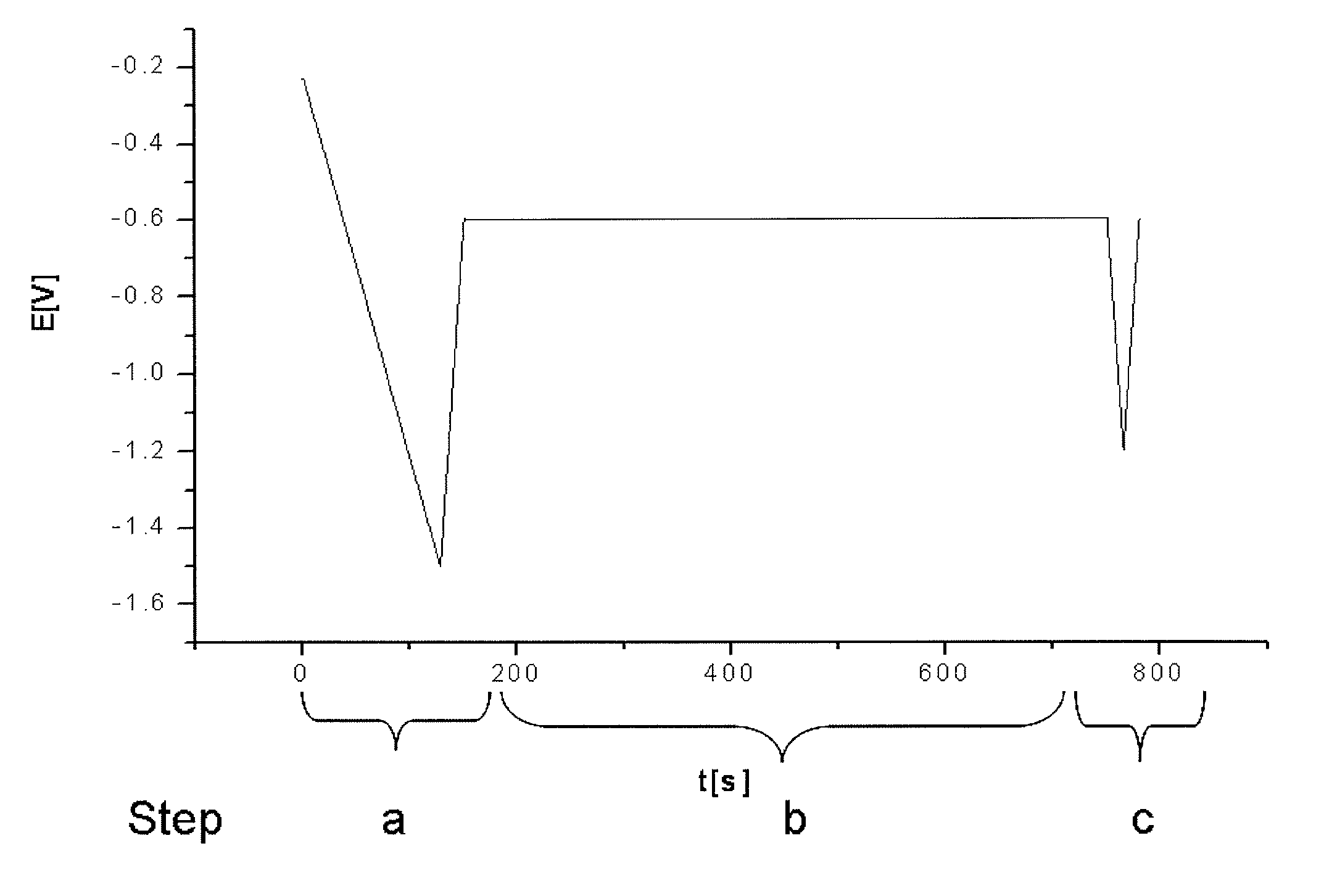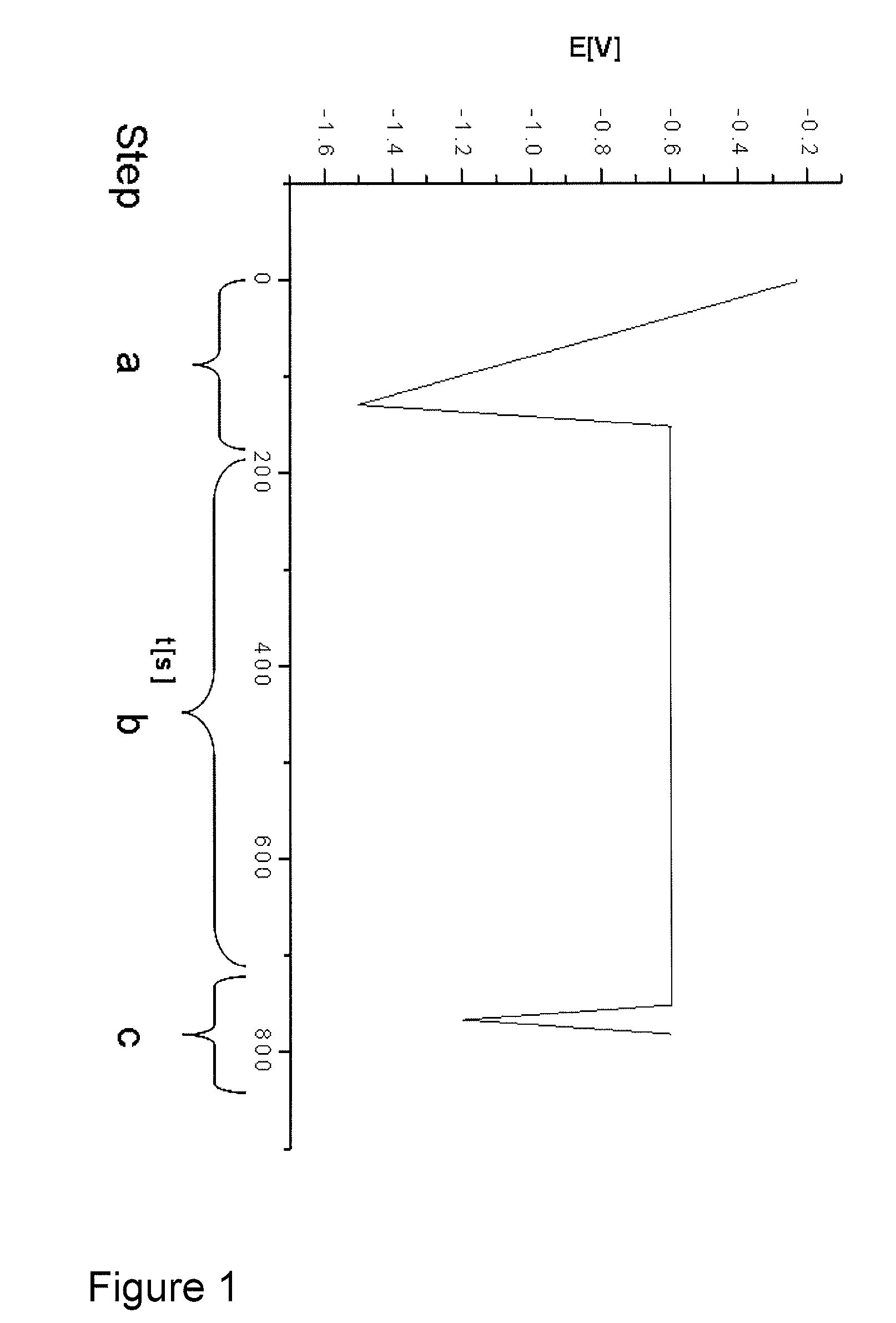Method for control of stabilizer additives in electroless metal and metal alloy plating electrolytes
a technology of electroless metal and metal alloy, applied in the direction of liquid/solution decomposition chemical coating, material electrochemical variables, instruments, etc., can solve the problem of complex analysis and control of said stabilizer additives or stabilizer additive mixtures
- Summary
- Abstract
- Description
- Claims
- Application Information
AI Technical Summary
Benefits of technology
Problems solved by technology
Method used
Image
Examples
example 1
[0063]The stabilizer additives of an electroless copper electrolyte were monitored. A copper plate (10×40 mm) was used as the working electrode. Both, working electrode and electrolyte were not agitated during steps a.-c. (table 1).
[0064]0 to 2 ml / l of a proprietary stabilizer additive mixture (Printoganth® PV, a product of Atotech Deutschland GmbH), comprising organic and inorganic sulphur compounds and organic nitrogen compounds were added to the electroless copper electrolyte. No cyanide ions were present in the stabilizer additive mixture.
[0065]The test protocol used for the control of the stabilizer additive mixture is summarized in table 1:
[0066]
Potential [V] ver-sus Ag / AgCl ref-Steperence electrodeRemarksa.Conditioning of−1.5→ reproducibleworkingworking electrodeelectrode:surface1. chemical etch-Na-persulphateingbased etch cleaner2. electrochemicalReduction of Cux+reductionto Cu0b.interaction of−0.610 min at fixedintermediates onpotentialworking electrodesurfacec.Analyzing; s...
example 2
[0068]The cyanide ion stabilizer additive of an electroless copper plating electrolyte was monitored. A copper plate (10×40 mm) was used as the working electrode. Both, working electrode and electrolyte were not agitated during steps a.-c. (table 1).
[0069]The cyanide ion stabilizer additive concentration was varied between 0 and 20 ppm.
[0070]The test protocol used was similar to the one shown in table 1, but instead of measuring the anodic oxidation current of the reducing agent formaldehyde in step c., now the cathodic reduction current of formaldehyde and / or its intermediate species with cyanide ion stabilizer additive was monitored in step c.
[0071]The results of the analyzing scan (step c.) are shown in FIG. 3. The impact of different cyanide ion stabilizer additive concentrations on the current / potential curves is clearly visible. Therefore, also the cyanide ion stabilizer additive can be monitored using the inventive method.
example 3
[0072]The reproducibility of the inventive method was investigated. To two portions of the electroless copper plating electrolyte stock solution 10 ppm of cyanide ions were added each and the test protocol shown in table 1 applied. The resulting current / potential curves for both samples are shown in FIG. 4. Both individual curves match almost completely. Therefore, the inventive method is reproducible.
PUM
| Property | Measurement | Unit |
|---|---|---|
| temperature | aaaaa | aaaaa |
| temperature | aaaaa | aaaaa |
| temperature | aaaaa | aaaaa |
Abstract
Description
Claims
Application Information
 Login to View More
Login to View More - R&D
- Intellectual Property
- Life Sciences
- Materials
- Tech Scout
- Unparalleled Data Quality
- Higher Quality Content
- 60% Fewer Hallucinations
Browse by: Latest US Patents, China's latest patents, Technical Efficacy Thesaurus, Application Domain, Technology Topic, Popular Technical Reports.
© 2025 PatSnap. All rights reserved.Legal|Privacy policy|Modern Slavery Act Transparency Statement|Sitemap|About US| Contact US: help@patsnap.com



